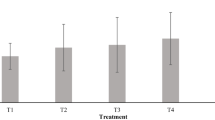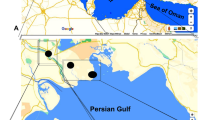Abstract
Shrimp Penaeus chinensis, 5--8 cm in body-length were held in laboratory aquaria after collection from culture ponds at Laoshan in Qingdao in 1992. The osmotic pressure and the concentration of inorganic components of hemolymph in the shrimp were measured. The optimum pH and osmolarity of the buffer were determined from tests on primary cultures of hepatopancreatocytes in vitro. The results indicate that the hemolymph is homoiosmotic to 27 ppt seawater at 870 mOsm/L; osmotic regulation of shrimp is strong in low-salinity seawater, but weak in high-salinity seawater; the concentration of Mg2+ ions in hemolymph is much less than that in seawater, while [K+] and [Ca2+] are much higher; hepatopancreatocytes in vitro have optimal survival at osmolarity range of 780-1, 100 mOsm/L and pH 6.5. Accordingly, an inorganic physiological buffer for P. chinensis (PPB, Penaeid Physiological Buffer) was prepared and contains NaCl, 23.0 g/L; K2SO4, 1.1 g/L; CaCl2, 1.6 g/L; MgSO4·7H2O, 1.6 g/L; NaH2PO4·2H2O, 0.35 g/L; NaHCO3, 0.05 g/L; pH 6.5; osmolarity, 867.9 mOsm/L. For storage of PPB, 4 stock buffers are made: 1) 10× PPB-A, which contains 230 g/L NaCl, 11 g/L K2SO4, and 3.5 g/L NaH2PO4·2H2O; 2) 40× PPB-B, which contains 64 g/L MgSO4·7H2O; 3) 40× PPB-C, which contains 64 g/L CaCl2; and 4) 100× PPB-D, which contains 50 g/L NaHCO2. In order to increase the buffering capacity, PPB may be modified (to His-PPB), in which 5 g/L Histidine·HCl is used as the buffer reagent in place of NaH2PO4 and NaHCO3.
Similar content being viewed by others
References
Chen NS et al. (eds) (1992). Biology of Penaeid Shrimp. Qingdao: Qingdao Ocean University Press (in Chinese).
Chen RM (ed) (1991). The Technology and Application of Animal Tissue Culture. Beijing: Science Press (in Chinese).
Chen S-N, Kou GH (1989). Infection of cultured cells from the lymphoid organ of Penaeus monodon Fabricius by monodon-type baculovirus (MBV). J Fish Dis 12: 73–76.
Cheng J-H, Liao I-C (1986). The effect of salinity on the osmotic and ionic concentrations in the hemolymph of Penaeus monodon and P. penicillatus. In: Maclean JL, Dizon LB, Hosillos LV (eds), The First Asian Fisheries Forum, pp 633–636. Manila, Philippines: Asian Fisheries Society.
Dall W (1981). Osmoregulatory ability and juvenile habitat preference in some penaeid prawns. J Exp Mar Biol Ecol 54: 55–64.
Frerichs GN (1996). In vitro culture of embryonic cells from the freshwater prawn Macrobrachium rosenbergii. Aquaculture 143: 227–232.
Hu K, Wang L, Duan Y, Zhang S (1990). Studies on a cell culture from the hepatopancreas of the oriental shrimp, Penaeus orientalis Kishinouye. Asian Fish Sci 3: 299–307.
Huang J, Yu J (1995). A new staining method for on-site observation of viral inclusion bodies of penaeid shrimp. Mar Fish Res 16: 31–39 (in Chinese).
Li ZC et al. (eds) (1963). Methodology in the study on aquatic organism. Shanghai: Shanghai Scientific and Technical Press (in Chinese).
Luedeman RA, Lightner DV (1992). Development of an in vitro primary cell culture from the penaeid shrimp Penaeus stylirostris and Penaeus vannamei. Aquaculture 101: 205–211.
MAIS (The Medicinal Assay Inst. of Shanghai) (1979). Clinical biochemical examinations. Shanghai: Shanghai Scientific and Technical Press (in Chinese).
Mitsuhashi J (1982). Media for insect cell cultures. In: Maramorosch K (ed), Advances in cell culture, vol. 2, pp 133–196. New York: Academic Press.
Parado-Estepa FD, Ferraris RP, Ladja JM, De Jesus EG (1987). Responses of intermolt Penaeus indicus to large fluctuations in environmental salinity. Aquaculture 64: 175–184.
Sun, XY et al. (eds) (1960). Analysis methods of hematic chemistry. Beijing: The Peoples Hygiene Press (in Chinese).
Waterman, TH (1960). The physiology of Crustacea. New York and London: Academic Press.
Author information
Authors and Affiliations
Rights and permissions
About this article
Cite this article
Huang, J., Song, XL., Yu, J. et al. The components of an inorganic physiological buffer for Penaeus chinensis. Methods Cell Sci 21, 225–230 (1999). https://doi.org/10.1023/A:1009876528852
Issue Date:
DOI: https://doi.org/10.1023/A:1009876528852




